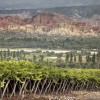Over the last decade the surface area of Pinot Noir in Argentina has grown 70% to almost 2,000 hectares. A number that places the red star of the Burgundy region among the fastest growing vines in the country. And the explanation is down to two things. Firstly that Argentina has established itself as producer of sparkling wines and secondly that local winemakers seem to have found their way back to this capricious varietal.
And in those quirks it is worth taking a moment. Pinot Noir doesn´t demand, it requires. If it doesn’t feel comfortable where it is being grown or is not treated well, it is impossible to achieve good wines. If that´s not capricious, please tell me what is. The first quirk is always that in Argentina where the climate of the vineyards is dry and hot, the chances of achieving good wines is scarce. But time and knowledge has settled things a bit. On the one hand, with the discovery of older vineyards in historic regions. On the other, with the arrival of new terroirs. All this amounted to greater expertise of local winemakers. And now Pinot Noir is no longer a pipe dream but a reality.
Patagonia, the beginning of the dream
The provinces of Neuquén and Rio Negro were the first to demonstrate that the country could develop high-end Pinot Noir. For example, in Alto Valle del Río Negro, and particularly in the area known as Valle Azul, the strain has been cultivated for decades with good results. The Patagonian winds that moderate the climate and heavy soils of the older vineyards allow for an elegant and subtle style that leads some to compare its labels with that of the Pinot Noir of Burgundy. Among the most delicate are those of Bodega Chacra, made with grapes from vineyards dating back to 1932 and 1955. In the same vein, Bodega Humberto Canale has its Marcus Gran Reserva and Old Vineyard, both with a sophisticated and refined profile. The winemaker Marcelo Miras offers one with a fresh and lively style with the brand Miras, while Bodega Aniello ensures a more modern profile.
In San Patricio del Chañar in Neuquén’s wine zone the search has always been more aligned with Californian Pinot Noir, with more intensity and flavour. Here Familia Schroeder stands out with Saurus Barrel Fermented or indeed the younger Saurus Patagonia Select. Bodega del Fin del Mundo, with its Reserve label offers a profile in the style of Sonoma while in the FIN line the ageing and storing allows for a style similar to Oregon.
With these results, winemakers ascertained that if moderate to cold climates were sought, it could change history and applied this criterion in the rest of the country.
Mendoza, key height
The main wine province with 75% of the 1,991 hectares of Pinot Noir in the country. However, in recent years the strain has gained prominence among other varietals. That is, from the development of high altitude vineyards in the Uco Valley, more precisely in Tupungato. At altitudes higher than 1,300m, Pinot Noir finally expresses full tipicity. The chill factor which helps to moderate the high temperatures in the region and the calcareous soils define the identity of this varietal in Mendoza. And so one obtains austere wines that benefit from fresh and lively acidity, a combo that gives rise to the precious elegance of Pinot Noir.
There are good examples in all price segments and two distinct styles. On one side are the sophisticated Pinots with New World profiles, like Salentein Single Vineyard, Luca G Lot, Bressia Piel Negra, Rutini Antología and Pulenta Estate Gran Pinot Noir. While the other style is more tied to the naked expression of place, with a light and delicate palate, something which can be appreciated in Zorzal Eggo Filoso, Montesco Punta Negra, Bousquet Reserva and Sophenia Reserva.
New extreme Pinots
In Argentina, Pinot Noir can be found in some remote and extreme corners. It is an aspect that has caught the attention of the wine press and sommeliers, because the amplitude of terroir for the variety now covers a vast area.
Growing Pinot on or near the coast may not be a new thing, but when you consider that 99% of the viticulture in Argentina is concentrated in Andes mountains, miles from the sea it takes on another meaning. Five years ago, Bodega Trapiche installed an experimental vineyard in Chapadmalal, a seaside resort in Buenos Aires with vineyards just 7km from the sea.
With the focus on white wines, it wasn’t long before thoughts turned to Pinot Noir. Their inspiration came from the reds of New Zealand influenced by the breezes from the Pacific Ocean. Here it’s the Atlantic which defines the character, and the result is quite similar to the Maori country. Light, with firm acidity and earthly tones, the first oceanic Pinot Noir of Argentina was bottled under the name Mar & Pampa and has already become a reference for lovers of the varietal.
In contrast, Bodega Colomé, took on the challenge of cultivating vines way up in the Andes and in 2003, finca Altura Máxima, the highest vineyard in the world at 3100m.a.s.l was planted in Salta. While the province is known for its spirited, deep reds with Cabernet Sauvignon and Malbec as their base, in this mountainous area the climate has led to them try their luck with Pinot Noir and Sauvignon Blanc. Even though the day ensures much sunshine, temperatures are very cold and this slows down the ripening process. And so Pinot Noir became the perfect red. With the 2013 vintage came a challenging wine with a deep colour, very different from what the varietal usually gives.
So, Pinot Noir offers a new field for the variety, both in styles and taste. And at last it is beginning to have its own space among the tranquil reds of the country. Not surprisingly then it is being planted more and more and is offering some of the newest wines from Argentina.



